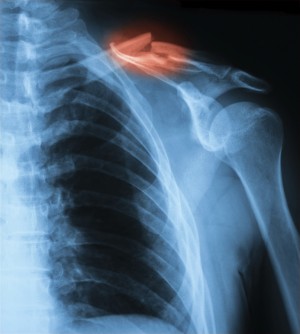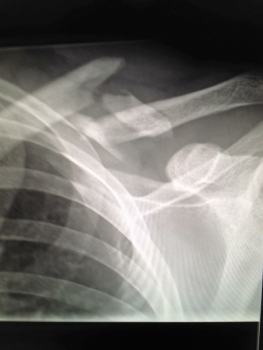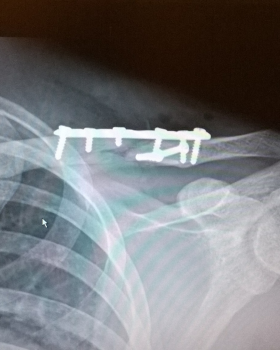
AC Sprains and Clavicle Fractures in Ice Hockey: Bio-mechanical perspective
Leave a CommentAC Sprains and other upper body injuries:
Research in the past has identified that approximately 70% of upper extremity injuries in ice hockey occur during games and that approximately 50% of them can be defined as a sprain, strain, or a fracture.3 The most common diagnosed injury of the shoulder in hockey today is a sprain of the Acromioclavicular (AC) joint, or AC Sprains.
 The AC joint is the connection of the outer end of your collarbone or clavicle, which attaches to the top of the scapula or shoulder blade. A stable AC joint is pivotal in relation to the mechanics of the shoulder. This joint allows the rotator cuff and scapula to function upon a stable framework when raising your arm over shoulder height. In conjunction with the clavicle, this joint, is supported by a number of ligaments that function as the only direct link between the upper extremity and the torso within the skeletal system.
The AC joint is the connection of the outer end of your collarbone or clavicle, which attaches to the top of the scapula or shoulder blade. A stable AC joint is pivotal in relation to the mechanics of the shoulder. This joint allows the rotator cuff and scapula to function upon a stable framework when raising your arm over shoulder height. In conjunction with the clavicle, this joint, is supported by a number of ligaments that function as the only direct link between the upper extremity and the torso within the skeletal system.
Injuries to this particular joint are commonly seen in contact sports and in situations where individuals fall on an outstretch arm.1 With this in mind, it is important to note that the prevalence of this injury is common in players participating in both checking and “non-checking” leagues and all players of all ages are susceptible to this particular injury. Due to the number of unforgiving objects such as the ice, goal posts, and the boards surrounding the ice, it is not shocking that over 50% of all shoulder injuries in hockey were found to be associated with a direct blow from one of these three objects. Studies have indicated that players within the ages of 16 to 18 years of age and those who weighed 160Ibs or more had a risk of shoulder injury two times that of the younger and lighter weight players.2 This may indicate there a relationship associated with the increase in magnitude of forces (speed, strength) of the players and the continued development of the shoulder complex in youth hockey players.
One may argue that an AC injury is typically related to body checking within the sport of ice hockey, however it should be known that AC sprains can occur in a direct or indirect manner. A direct contact injury would be the result of a blow (delivered or received) to/from another player, or an unforgiving surface, to the top edge of the scapula causing a downward and distractive force to the ligaments of the AC joint.1 If AC Sprains are severe enough a visible upward protrusion of the clavicle may be seen due to the tension produced by the upper trapezius. This is known as a “step” deformity and is commonly seen in other contact sports.
An indirect injury to the AC joint is related to an upward or superior force pushing the upper arm or the head of humerus into the AC joint causing a disruption of the ligaments. This type of injury may be less apparent due to the possible lack of the “step” deformity but still results in a mechanically disruption of the shoulder’s over stability.1 This type of injury is commonly seen when a player falls to the ice and attempts to brace their fall with an outstretched arm that is slightly flexed (bent) and adducted (close to the body).
Each of these conditions may vary in severity and thus may require different types of medical or rehabilitative treatments. In extreme cases a clavicle fracture may also be present due to the traumatic nature of the injury. This particular condition must be ruled out with radiographic testing to ensure each injury is properly managed and that each player returns to play as safe and as fast as possible. In extreme cases surgery is required to maintain the individual’s overall structure of their clavicle and long-term function of the shoulder.
The radiographs below are of a 39 year old male that collided into the boards with an out stretched arm fracturing his clavicle into 4 pieces. After his surgical intervention and physical therapy program he returned to the ice with no physical restrictions or limitations.


Symptoms of AC sprains
– Pain over the end of the collarbone
– Step up deformity
– General shoulder pain that is described as achy or sharp
– Pain when moving the shoulder past shoulder height
– Swelling/Bruising
Measures for Prevention
– Careful monitoring of the ice surface prior to and during practice and games
– Proper use and fitting of shoulder pads and skates
– Proper education of hitting techniques (receiving a check, giving a check)
– Active shoulder warm ups prior to skating
– Participating in an age dependent off season shoulder strengthening
– Monitoring the general fatigue levels of players during tournaments
– Officials upholding the rules of the game to manage/reduce the risks of illegal hits
Management if Injured
– RICE (Rest, Ice, Compression, Elevation) to reduce swelling and inflammation
– Use a sling to immobilize and unload the “hanging” tension of the arm through the AC joint and to reduce further inflammation/pain.
– Seek further consultation from an orthopedic physician or physical therapist
Click to Request an Appointment Today
The Athletico blog is an educational resource written by Athletico employees. Athletico bloggers are licensed professionals who abide by the code of ethics outlined by their respective professional associations. The content published in blog posts represents the opinion of the individual author based on their expertise and experience. The content provided in this blog is for informational purposes only, does not constitute medical advice and should not be relied on for making personal health decisions.
1- Beim GM. Acromioclavicular Joint Injuries. Journal of Athletic Training. 2000;35(3):261-267.
2- Finke, R. C., Gerberich, S. G., Madden, M., Funk, S., Murray, K., Priest, J. D., & Aamoth, G. M. (1988). Shoulder Injuries in Ice Hockey *. J Orthop Sports Phys Ther Journal of Orthopaedic & Sports Physical Therapy, 10(2), 54-58.
3- Jouko Mölsä, Urho Kujala, Pertti Myllynen, Ilkka Torstila, and Olavi Airaksinen. Injuries to the Upper Extremity in Ice Hockey: Analysis of a Series of 760 Injuries Am J Sports Med September 2003 31, 751-757.
